Abstract
In this research, a thermoelectric generator is used to absorb waste heat on the walls of a wood charcoal burning stove to produce electrical energy. The research was carried out using 4 Thermoelectric Generators (TEGs) attached to the outer wall of the furnace. The walls of the charcoal stove’s combustion chamber are designed with aluminum plates. A water block cooling system with water flow is used to overcome the increase in heat at the cold side of TEG. The DC water pump power used to circulate the water block is 215 L/h, 275 L/h, 320 L/h, 350 L/h, 375 L/h, and 400 L/h. This research aims to find the most optimal water flow rate at a water block. Temperature measurements are carried out on the recent and bloodless facets of the TEG, and the temperature of the inlet and outlet water of the water block. Changes in TEG voltage, current, and output power are recorded with a multimeter connected to the acquisition data. Analysis of energy balance and heat transfer was carried out in the furnace’s combustion chamber. The experimental results show that the cooling water flow rate of 275 L/h can produce the highest electrical power, around 11.17 W. The use of TEGs as a medium for generating electrical energy from wasted heat through the furnace’s walls can meet some of a household’s electrical energy needs.
1. Introduction
Thermoelectric generators (TEGs) have been used commercially for some time, for example, as a power source while in space [1,2]. In addition to thermoelectricity (TE), the operation of thermoelectric converters requires hot and bloodless faucet insulation plates with low thermal resistance [3], which directly generates electrical energy from waste heat sources, displaying promising outcomes in contributing to decreasing greenhouse fuel emissions and supplying a cleaner form of electricity performance of a photovoltaic–thermoelectric generator panel in combination [3,4,5]. In Indonesia, especially in the Province of Central Java, we often find many drinking stalls or “wedangan” places on the side of the road where there are only lights from candles or torches and the like [6].
The background of this research is an effort to meet the electricity needs on the side of roads where there is no electricity network by utilizing waste heat from the charcoal stoves owned by these stalls. Then, a thermoelectric generator powered by stove heat is used, comprising the load system, the thermoelectric generator system, and the stove system. When the biomass fuel is burned in the stove, some energy flows to the TEG and is converted into electricity. Thermoelectric (TE) devices have become a popular kind of alternative energy in recent years. Thermoelectric power generation from waste heat may efficiently increase energy consumption efficiency and address issues with resource scarcity and environmental degradation [7]. With its environmentally friendly applications, such as for hot water pumps and electricity generators, plus the issue of global warming and limited energy resources, TEGs are gradually attracting world attention [8]. Solid-fuel stoves, such as wood-fueled stoves, can be connected to a micro-scale power plant, which is realized using a thermoelectric generator [9]. In an electric device called a TEG generator, heat (or temperature differential) is converted directly into electrical energy [10]. Seebeck originally identified the thermoelectric phenomenon in 1822 after seeing the flow of electricity when there is a temperature differential between two objects, with two dissimilar metals combined in one wild place while the other temperature difference is stored at a lower temperature [11,12]. Through the Seebeck effect, the thermoelectric module (TEM) provides a technique for directly converting heat into electrical energy [13]. Unlike conventional dynamic heat engines, there are no moving parts in this thermoelectric generator, and it makes no noise [14]. The Experimental Investigation of Heating Rate Variant Method to Produce Power Output Generated by Thermoelectric Generator SP1848-SA [15]. Besides that, thermoelectric energy is an alternative energy with many advantages, such as being light, small, and cheap in the production process [16]. Utilization of the TEG module for waste heat has been carried out by Yousef S.H. et al., with the title Thermoelectric Stove Performance and Heat Transfer Analysis. In his study, 12 TEG modules were installed on the outer wall of the furnace by utilizing the exhaust gas from burning the charcoal stove. An air conditioning system with a harness heatsink was used to dissipate heat from the cold side of the TEG. In addition, the wasted heat in the form of gas is also used for cooking and heating water.
2. Method
Heat transfer analysis in this system was studied, mainly transferring the TEG module’s exhaust gas into electrical energy. The results showed that the maximum power the module could produce by utilizing exhaust gas in the adang furnace was 7.8 watts [17]. However, research on high-performance TE generators still needs to be improved. Therefore, it is crucial to design better and more efficient device structures using existing TE materials to improve TE device performance. Experiments were carried out by attaching 4 TEG modules to the outer wall of the charcoal furnace arranged in series. By altering the electric power of the DC pump by 1, 2, 3, 4, and 5 watts, the flow rate of cooling water may be adjusted. The experiment used wood charcoal as the fuel for 20 min, and the temperature of the charcoal during that time was taken to be constant. The measurement process in this experiment was carried out on the TEG system that was installed in the form of temperature, electric current, and voltage generated by the TEG module. The temperature on the system was taken by utilizing an Arduino Mega2560 microcontroller combined with the MAX6675 sensor and connected to a K-type thermocouple. TEG performance in the form of current and voltage is measured using the MAX471 sensor in combination with an Arduino Uno microcontroller. TEG loading uses a 12 V battery. The loading aims to determine the TEG performance produced according to the following formulation rules:
where P is the power coming out of the TEG, V is the voltage, and I is the electric current. The research scheme and data collection process can be seen in the Figure below.
P = V × I
2.1. Data Retieval Process
There are two stages in the data collection process. The first is to collect water flow rate data by varying the water flow rate of 215, 275, 320, 350, 375, and 400 L/h. The second data collection by loading the battery. Figure 1 and Figure 2 explain the data collection scheme for variations in the flow rate of water entering and leaving the waterblock by varying the flow rate of cooling water by adjusting the power entering the pump.

Figure 1.
Installation schematic of temperature data ΔT TEG for water in and out of the waterblock.

Figure 2.
Schematic diagrams of collecting data: (a) temperature on surface TEG, (b) voltage and current output, (c) Temperature on the waterblock.
2.2. Energy Balance in the Furnace
Figure 3 shows a schematic of the energy balance that occurs in a wood charcoal stove, where the first rule of thermodynamics states that energy cannot be generated or destroyed. On the basis of the first law of thermodynamics, the energy balance that occurs in the furnace is in the following form:
- -
- Incoming heat energy (Qin): Qair and Qfuel;
- -
- Hot energy out (Qout): Qgass and Qwall.

Figure 3.
Schematic of the energy balance of the furnace.
The energy balance that occurs in the stove is as follows:
Qin = Qout ⟶ ηc. Qfuel = Qgass + Qwall
2.3. The Energy Equation That Enters the Furnace Is in the Form of Fuel (Qfuel)
Qfuel is the heat energy that enters the furnace in the form of fuel, which also causes combustion due to a mixture of fuel (charcoal) and air, so the equation for the incoming energy is as follows:
Qfuel = mf × LHV
2.4. Equation of the Energy That Comes Out of the Furnace in the Form of Gas (Qgas)
Qgas is the heat energy released from the furnace heat source to the outside without any wall obstructions. Qgas in the furnace is the main heat energy that is used as a heater for cookware. The equation that occurs in Qgas is as follows:
2.5. The Equation for the Transfer of Energy out through the Furnace Wall (Qwall)
Qwall is the energy balance leaving the furnace through the wall as shown in Figure 4. Because the dimensions of the wall thickness are very small, heat transfer occurs by convection and radiation. To find the heat transfer that occurs in the furnace wall, the energy balance equation is given as follows [11]:
Qin.wall = Qout.wall ⟶ Qrad in + Qcon in = Qconv out + Qrad out

Figure 4.
Energy balance on the furnace wall.
3. Result and Discussion
3.1. Optimization of Water Flow Rate on TEG Performance
In this experiment, the electric power used to circulate water in the waterblock from the DC water pump was varied starting from 0.5, 1, 2, 3, 4, and 5 watts. Based on measurements with a flow meter, the power produces a flow rate of 215, 275, 320, 350, 375, and 400 L/h, respectively. Figure 5 shows the impact of the differential on the flow rate of cooling water in TEG hot and cold surface temperatures. All flow rates may absorb heat, which influences the temperature differential at TEG, according to the findings of TEG temperature tests with different cooling water flow rates. This is due to the variable or inconsistent charcoal temperature in each TEG. As seen from the trend of the curve that occurs, the cooling water flow rate of 275 L/h produces the highest TEG surface temperature difference, so the optimal use of cooling water flow rate to cool the TEG cold side surface is a cooling water flow rate of 275 L/h.

Figure 5.
The relationship between surface ΔT TEG and time with variations in the cooling water flow rate.
Figure 6 shows the impact of changes in the cooling water flow rate on the typical temperature differential between the waterblock’s intake and exit. From the results of data collection in the experiment, information was obtained that at water flow rates of 215, 275, 320, 350, 375, and 400 L/h, each produced an average difference in inlet and outlet water temperatures of 277, 280.9, 239.2, 277.2, 277.4 and 276.5 K. Thus, the flow rate of 275 L/h obtains the highest average temperature difference or is the most optimal in absorbing heat on the TEG surface, resulting in the highest water temperature difference.
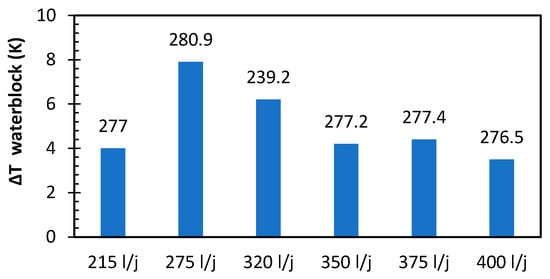
Figure 6.
The relationship between the average temperature of ΔT water before and after entering the waterblock over time with variations in the flow rate of cooling water.
Figure 7 shows the effect of the cooling water flow rate on the voltage generated by the TEG. The increase in curves for all variations tends to be the same, namely experiencing a significant increase in the first 600 s. Furthermore, the voltage tends to drop. In Figure 7, the curve that dominates the voltage increase produced by TEG is obtained at a flow rate variation of 275 L/h with a maximum output voltage in the range of 23.5–24.8 volts. This is because the water flow rate of 275 L/h is optimal for cooling the TEG surface.
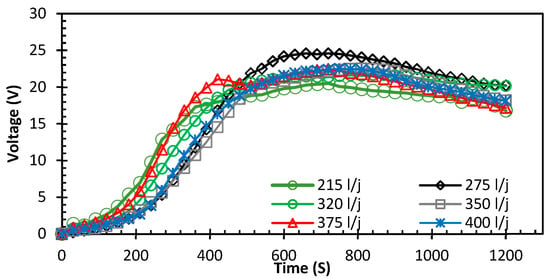
Figure 7.
The relationship between the voltage generated by the TEG over time and the cooling water flow rate.
Figure 7 shows the impact of the water flow rate on the TEG’s voltage output. Figure 4 illustrates how the TEG’s voltage output is significantly influenced by the water flow rate. The highest voltage created by the TEG module at 275 L/h is 24.68 V, whereas the maximum voltage produced by the water flow rate at 215 L/h is 20.63 V. However, there is a progressive drop in voltage as the rate increases.
For this purpose, the TEG temperature is taken at the same temperature, namely 145.75 °C. This is because the maximum temperature of the Thot TEG side is the lowest among the variations in the flow rate of cooling water produced by the flow of cooling water with a flow rate of 320 L/h, indicating the temperature of the hot side (Thot) is 145.75 °C. With different water flow rates, Tcold, Tin, Tout, ∆Twater, ∆TEG, and different voltages are obtained at the same Thot TEG temperature. Of the six variations in the flow rate of cooling water, it can be concluded that the best flow rate is obtained when the difference between the highest TEG temperature and the highest voltage is at a water flow rate of 275 L/h are shown in Table 1.

Table 1.
A comparison of the cooling water flow rate to the effect of temperature and voltage generated by the TEG.
3.2. Effect of Water Flow Rate as Surface Cooling Media on TEG Performance with Battery Loading
From Figure 8, the experiment looked at how the performance of the TEG was affected by changes in the water flow rate used as a cooling medium for the TEG surface, in this case, the TEG power. Flow becomes 320, 350, 375, and 400 L/h, which only produces a maximum voltage of 21.69 V at a flow rate of 320 L/h, 21.53 V at a rate of 350 L/h, 22.44 V at a flow rate of 375 L/h, and 22.51 V at a flow rate of 400 L/h. This makes the cooling water flow rate suboptimal to cool the TEG surface, so the most optimal flow rate is 275 L/h because it produces the highest TEG output voltage.
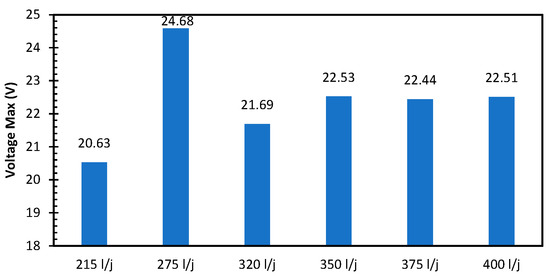
Figure 8.
The relationship between the maximum voltage generated by TEG over time with variations in the cooling water flow rate.
To find out the performance produced by TEG, it is necessary to have an external load in the form of DC lamps, batteries, and electronic devices with DC current sources. In this experiment, a 12 V battery was used as an external load so that the TEG performance in the form of electrical power could be analyzed. Data collection in this experiment was carried out on system temperature, voltage, and current coming out of the TEG.
3.2.1. Cooling Water from a Faucet That Flows Continuously
Figure 9 shows the effect of the flow rate with an unlimited volume of cooling water on the Thot and Tcold TEG temperatures. The maximum temperature on the Thot side is 463.5 K, the Tcold side is 347.5, and the maximum ΔT TEG is 389 K.
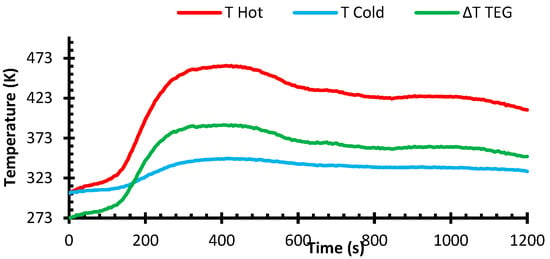
Figure 9.
Relationship between Thot, Tcold, and ∆T TEG temperatures with respect to time when cooling using water flows continuously.
Figure 10 shows the relationship between the current generated by TEG and time. From Figure 10, information is obtained that the curve shows that the 540th second reaches the maximum current generated by TEG, which is 0.823 amperes.
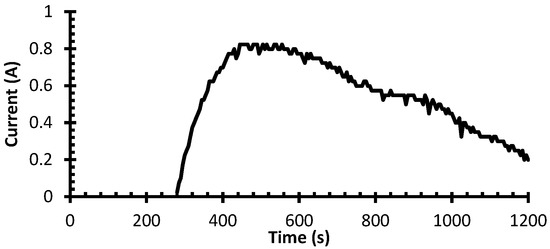
Figure 10.
The relationship between the current strength generated by TEG against time.
Figure 11 shows the relationship between the power generated by TEG and time. From Figure 11, the curve shows that after 540 s, the maximum power generated by TEG is 11,171 watts.
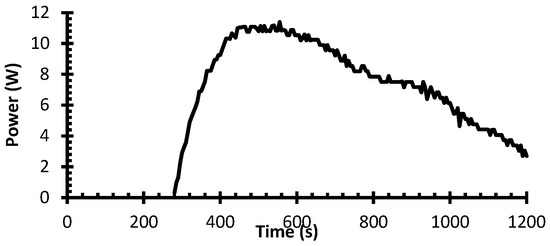
Figure 11.
The relationship between the power generated by the TEG and time.
3.2.2. Cooling Water with a Volume of 9 L of Water
Figure 12 shows the effect of the flow rate with a volume of 9 L of water on the Thot and Tcold TEG temperatures. The maximum temperature on the Thot side is 433.5 K, the Tcold side is 329.5 K, and the maximum ΔT TEG is 379.5 K.
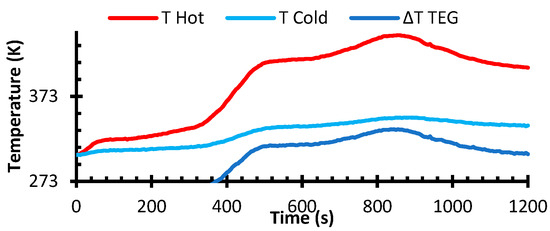
Figure 12.
Relationship between Thot, Tcold, and ∆T TEG temperatures with respect to time when cooling use 9 L of water.
Figure 13 shows the impact of TEG current generation on the cooling water flow rate. From Figure 9, the curve shows an unstable up-and-down current, and the maximum current generated is 0.723 amperes.
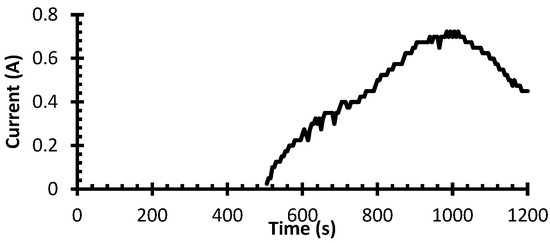
Figure 13.
The relationship between TEG current strength and time.
Figure 14 shows the effect of the flow rate of cooling water with a volume of 9 L on the power generated by the TEG. From Figure 14, the curve reads starting at 505 s increase unstably, and after 540 s, the maximum power generated by TEG is 10,515 watts.
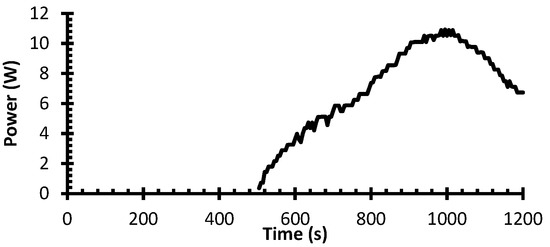
Figure 14.
TEG power relationship with time.
4. Conclusions
The results of the study can be concluded that variations in the flow rate of cooling water in and out of the waterblock and variations in battery loading greatly affect the generator’s thermoelectric performance, including the following: Variation of the flow rate of cooling water by adjusting the power that goes into the most optimal DC pump used as a regulator of the flow rate of TEG surface cooling water is 270 L/h, which produces a voltage of 24.68 volts, whereas the pump power variations of 215, 320, 370 and 400 L/h produce lower voltages ranging from 19 volts to 22 volts. And the TEG’s performance by utilizing wasted heat in a charcoal stove produces a maximum power of 11,177 watts.
Author Contributions
H.L.W.: conceptualization, investigation, and writing—review and editing; A. and Y.: supervision and technical review and validation; N.T.A.: resources, supervision, and validation; A.T.S.: review and editing. All authors have read and agreed to the published version of the manuscript.
Funding
This research received no external funding.
Institutional Review Board Statement
Not applicable.
Informed Consent Statement
Not applicable.
Data Availability Statement
The raw data supporting the conclusions of this article will be made available by the authors on request.
Acknowledgments
The authors acknowledge the assistance provided by Politeknik Industri Logam Morowali in completing this study.
Conflicts of Interest
The authors declare no conflicts of interest.
References
- Ioffe, A.F. Semiconductor Thermoelements and Thermoelectric Cooling; Pion Ltd.: London, UK, 1958. [Google Scholar]
- Atmoko, N.T.; Riyadi TW, B.; Wijayanto, H.L. The Experimental Investigation of Heating Rate Variant Method to Produce Power Output Generated by Thermoelectric Generator SP1848-SA. J. Phys. Conf. Ser. 2022, 2406, 012008. [Google Scholar] [CrossRef]
- Champier, D.; Bédécarrats, J.P.; Kousksou, T.; Rivaletto, M.; Strub, F.; Pignolet, P. Study of a TE (thermoelectric) generator incorporated in a multifunction wood stove. Energy 2011, 36, 1518–1526. [Google Scholar] [CrossRef]
- Disalvo, F.J. Thermoelectric cooling and power generation. Science 1999, 285, 703–706. [Google Scholar] [CrossRef] [PubMed]
- Fitriani; Ovik, R.; Long, B.D.; Barma, M.C.; Riaz, M.; Sabri, M.F.M.; Said, S.M.; Saidur, R. A review on nanostructures of high-temperature thermoelectric materials for waste heat recovery. Renew. Sustain. Energy Rev. 2016, 64, 635–659. [Google Scholar] [CrossRef]
- Jaziri, N.; Boughamoura, A.; Müller, J.; Mezghani, B.; Tounsi, F.; Ismail, M. A comprehensive review of Thermoelectric Generators: Technologies and common applications. Energy Rep. 2020, 6, 264–287. [Google Scholar] [CrossRef]
- Kishore, R.A.; Priya, S. A Review on low-grade thermal energy harvesting: Materials, methods and devices. Materials 2018, 11, 1433. [Google Scholar] [CrossRef] [PubMed]
- Kütt, L.; Millar, J.; Karttunen, A.; Lehtonen, M.; Karppinen, M. Thermoelectric applications for energy harvesting in domestic applications and micro-production units. Part I: Thermoelectric concepts, domestic boilers and biomass stoves. Renew. Sustain. Energy Rev. 2018, 98, 519–544. [Google Scholar] [CrossRef]
- Li, Y.; Wang, S.; Zhao, Y.; Yue, L. Effect of thermoelectric modules with different characteristics on the performance of thermoelectric generators inserted in the central flow region with porous foam copper. Appl. Energy 2022, 327, 120041. [Google Scholar] [CrossRef]
- Maksymuk, M.; Zazakowny, K.; Lis, A.; Kosonowski, A.; Parashchuk, T.; Wojciechowski, K.T. Development of the anodized aluminum substrates for thermoelectric energy converters. Ceram. Int. 2022, 49, 4816–4825. [Google Scholar] [CrossRef]
- Najjar, Y.S.H.; Kseibi, M.M. Heat transfer and performance analysis of thermoelectricgia stoves. Appl. Therm. Eng. 2016, 102, 1045–1058. [Google Scholar] [CrossRef]
- Purohit, K. Review Paper on Optimizations of Thermoelectric System. Int. J. Innov. Res. Eng. Manag. (IJIREM) 2016, 3, 259–263. [Google Scholar]
- Riyadi, T.W.B.; Utomo, B.R.; Effendy, M.; Wijayanta, A.T.; Al-Kayiem, H.H. Effect of thermal cycling with various heating rates on the performance of thermoelectric modules. Int. J. Therm. Sci. 2022, 178, 107601. [Google Scholar] [CrossRef]
- Sornek, K.; Filipowicz, M.; Żołądek, M.; Kot, R.; Mikrut, M. Comparative analysis of selected thermoelectric generators operating with wood-fired stove. Energy 2019, 166, 1303–1313. [Google Scholar] [CrossRef]
- Atmoko, N.T.; Riyadi TW, B.; Utomo, B.R.; Jamaldi, A.; Nugroho, A.S. Heat Transfer Analysis and Performance Investigation of Generator Thermoelectric Applied in LPG Stove Waste Heat Recovery. Int. J. Renew. Energy Res. 2023, 13, 70–76. [Google Scholar]
- Wijayanto, H.L.; Amiruddin, A.; Kadriadi, K.; Wirakusuma, K.W.; Atmoko, N.T. Pengaruh Variasi Daya Pompa pada System Pendinginan TEG terhadap Tegangan yang Dihasilkan TEG. J. Ilm. Univ. Batanghari Jambi 2022, 22, 477. [Google Scholar] [CrossRef]
- Zheng, X.F.; Liu, C.X.; Yan, Y.Y.; Wang, Q. A review of thermoelectrics research—Recent developments and potentials for sustainable and renewable energy applications. Renew. Sustain. Energy Rev. 2014, 32, 486–503. [Google Scholar] [CrossRef]
Disclaimer/Publisher’s Note: The statements, opinions and data contained in all publications are solely those of the individual author(s) and contributor(s) and not of MDPI and/or the editor(s). MDPI and/or the editor(s) disclaim responsibility for any injury to people or property resulting from any ideas, methods, instructions or products referred to in the content. |
© 2024 by the authors. Licensee MDPI, Basel, Switzerland. This article is an open access article distributed under the terms and conditions of the Creative Commons Attribution (CC BY) license (https://creativecommons.org/licenses/by/4.0/).